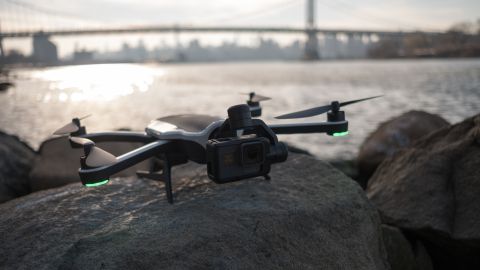Why you can trust TechRadar
GoPro claims the Karma drone can operate as far as 1.86 miles (3km) away and 1.99 miles (3.2km) high, and in our experience, it lives up to these numbers. However, this seems like only a small achievement when you consider the DJI Mavic Pro’s maximum range of 4.3mi (7km).
Since the Karma Drone communicates over Wi-Fi, it has a much shorter range compared to the radio signals DJI employs. Likewise, the Karma Drone zips around at a max speed of 35mph (56km/h), which is quick to be sure, but the Mavic Pro edges ahead at 40mph (65km/h).
Battery life is this quad’s most glaring weak point. Lasting only 17 to 20 minutes tops, you’ll almost always spend more time getting to a destination than capturing aerial footage of it. Meanwhile, both the Yuneec Typhoon and DJI Mavic Pro can stay in the sky for roughly 25 minutes.
All in all, the GoPro Karma Drone offers solid performance and capabilities for a first-time flier. However, it’s clear the Mavic Pro will give you the extra legs you need to fly higher, faster and for longer.
Video capture
One area where the Karma Drone leads in is top-notch video quality, thanks to the GoPro Hero5 camera. Video looks crisp with thorough detail, vibrant colors and a broad dynamic range.
The three-axis camera gimbal and the Karma’s rotors work together to keep footage stable and, from what we’ve seen, it works stupendously well. Even with the drone racing around at maximum speed, the resulting video clips look like they could have been shot on a professional-grade crane or dolly.
GoPro is also well attuned to the needs of its active users, and makes editing on the fly easy with a pair of mobile apps. In just a few minutes we clipped a snippet of footage through Quik, replaced the audio in Splice, and uploaded it all from our phone.
Handheld stabilizer
Of course, capturing video on the GoPro Karma is only half of the story. Popping out the camera's stabilizer and inserting it into the included Karma Grip lets you record your on-foot adventures.
The handheld stabilizer basically smooths out any unwarranted bumps as you walk around – at least that’s how it should work on paper. In reality, the Grip does add a lot of stabilization, but there’s still a noticeable wobble upon every step.
There’s just too much vertical and longitudinal movement to contend with, though we found we could further minimize camera shake by deliberately walking from heel-to-toe. Turning on the GoPro Hero5's electronic image stabilization’s is another solution, but you’ll limit your video’s resolution to Full HD.

Despite the so-so performance on foot, the stabilizer is rock-solid for capturing slowly-panning footage. The gimbal keeps the camera on a level plane while gently turning with the direction of the handle. Alternatively, with a press of a button, you can lock the camera’s tilt as well.
GoPro also introduced a Karma Grip Extension Cord in April 2017 that allows you to more easily mount the three-axis gimbal to helmets and car mounts. The 35-inch (89cm) coiled cable essential frees you from the battery grip that made it awkward to attach to anything but a bag strap.
That said, this $99 (about £80, AU$130) add-on accessory is a bit expensive considering the Karma Grip itself goes for $299 (£289, AU$499).

We only wished it had a joystick for manually changing the camera’s orientation, or an extra mode for locking the camera in one direction. Despite not being as nuanced as 3-axis gimbals designed for mirrorless cameras and DSLRs, it’s a handy device for recording some establishing shots and extra handheld footage that’s relatively well stabilized.
Unfortunately, the Karma Grip’s servos are also loud enough to be heard in your footage, which makes it unusable for vlogs unless you’ve also plugged in an external microphone. It’s not a huge problem in our book, though, as you wouldn’t want to use the GoPro Hero5’s stock microphone in the first place.
Current page: Performance and video quality
Prev Page Introduction, design, build and handling Next Page VerdictKevin Lee was a former computing reporter at TechRadar. Kevin is now the SEO Updates Editor at IGN based in New York. He handles all of the best of tech buying guides while also dipping his hand in the entertainment and games evergreen content. Kevin has over eight years of experience in the tech and games publications with previous bylines at Polygon, PC World, and more. Outside of work, Kevin is major movie buff of cult and bad films. He also regularly plays flight & space sim and racing games. IRL he's a fan of archery, axe throwing, and board games.


